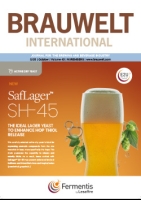Hop pellets, conventional hop extracts (ethanol and CO2), isomerized kettle extracts (IKE, PIKE) and light stable kettle extracts (LSKE) are the products usually used in the brew house. Besides excellent storage stability, hop extracts are homogenous and therefore can be dosed precisely to add mainly bitterness to the beer.
British hop growers have the most exciting prospects since the 1960s, said Simon Jackson, Chief Executive of the Institute of Brewing and Distilling (IBD), speaking at the presentation ceremony for the Institute’s annual “English Hop Competition”.
Our new CO2-Extraction plant in Mainburg, which has a capacity of approx. 4,000 tons of hops per year, started up in autumn 2010. This new investment is an extremely important addition to our well-established Ethanol-Extraction plant.
Due to its high oxidative potential, ozone is a highly reactive molecule that is able to oxidize and mineralize inorganic and organic materials. In water, ozone decomposes into oxygen for which reason it seems to be an ideal candidate for removal of persistent substances and microbes during water treatment. Today, ozone is widely applied in water processing of drinking and process water. Other possible applications for treatment and disinfection of surfaces in medical areas and food processing are currently under development and will be further described in the next part of this article series. This review gives an overview over the current state-of-the art in ozone production and possible operational areas.
BrewingScience - Monatsschrift für Brauwissenschaft, 64 (January/February 2011), pp. 8-12
The present study reviews changes in the requirements for malting quality and collection of malting barley varieties in the Czech Republic in 2010. It gives micromalting results and results of malt and wort analyses of 22 most widespread and new malting barley varieties registered in the Czech Republic. Varieties causing haze were withdrawn from the collection. The actual collection includes two groups of malting barley varieties. The varieties with high activity of hydrolytic enzymes and high attenuation and the varieties recommended for production of beer with the Protected Geographical Indication Czech Beer, i.e. varieties with lower degree of final attenuation, lower values of Kolbach index, friability, etc.
BrewingScience - Monatsschrift für Brauwissenschaft, 64 (January/February 2011), p. 1-7
To many settlers and later immigrants St. Louis became a synonym for the first step into the unknown, but also for an independent future. It took a lot of energy, initiative and confidence in their own abilities to be able to take this risky step and break new ground – the typical American dream. For brewers, this holds true to the present day. The U.S. craft brewers community provides a fascinating and unconventional environment, full of spirits– a hotbed of ideas. This sounded so attractive that a young German brewer and his American colleague, David Wolfe, dared to take the first steps into self-employment. BRAUWELT International talked with Florian Kuplent about his personal American dream.
How bitter are the beers we drink? And how much has the bitterness changed over the years? Although beer production has been growing worldwide for several years now, hops have been used less on average per hl of beer. The trend towards less bitter beers started several decades ago and should be seen in connection with the global distribution of certain brands of beer and the resultant homogenisation of the taste experience. In order to establish how marked this trend is and where it will lead, the Barth-Haas Group began to conduct annual analyses of various brands of beer to examine bitterness in 2006. The results of these analyses are presented in the article below. For the sake of clarity, only the results of the 2009 surveys have been taken.
Hops are one of the most interesting areas of research worldwide and all possible applications for hops are far from having been identified. The Barth-Haas Group awards grants for research projects into hops each year. The grants are intended for students who are looking for a topic for their seminar papers, thesis or Master’s thesis dealing with hops and their applications in the brewing industry. The results of the 2008 research are presented below.
Few topics in brewing science are as controversially discussed as the evaluation and usage of hops. A minimum goal of hopping is the generation of a slight bitter flavour without requirement of any additional sensory properties, though positive side-effects such as light stability for certain bottle types or improved head retention are often noted as desirable characteristics. Hops are also considered to be a spice and the vast range of available hop varieties and possible hopping technologies allow them to contribute significantly to the character and flavour of a beer. The ultimate goal would thus be to strive for an inimitable and singular sensory experience.
Mycotoxins are a diverse range of molecules that are harmful to humans. They are secondary metabolites secreted by moulds, mostly Penicillium and Fusarium. Because of their antimicrobial activity it is most unlikely that hops could be considered a source for mycotoxins. In order to confirm this we again monitored the situation concerning residues of most toxic mycotoxins by screening hops after the last harvest. In our investigations, all major European varieties from different growing areas were considered. To guarantee a representative analysis, ten samples of large lots were selected and then combined into one composite sample for each variety. These results for the 2010 crop are presented in the table below.
Downstream products, such as regular iso extract, rhohydro-iso-, terahydro-iso- and hexahydro-iso extracts, are usually dosed prior to filtration. However in practice some brewers are still adding these extracts after filtration, when there is a distinct risk of precipitation in beer and therefore also of inducing gushing.



